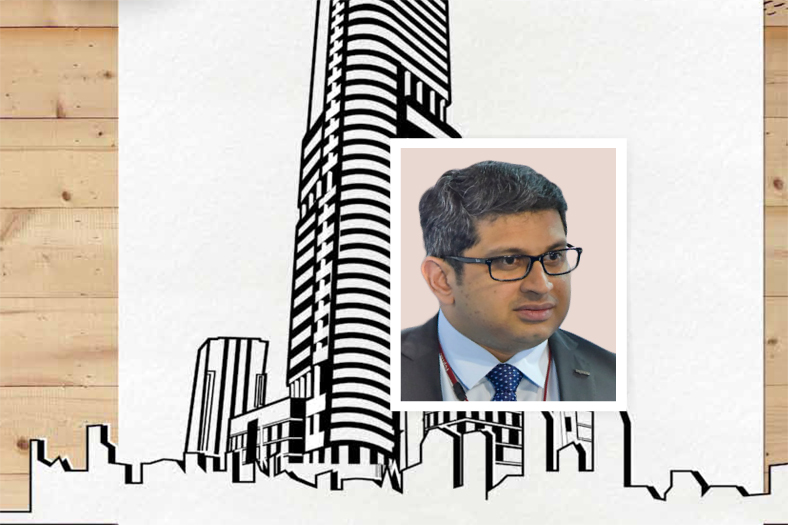Aiming High
This article will shed light on the challenges faced while installing elevators in super tall structures.
With the scarcity of land in urban areas, buildings are expanding vertically. Therefore, there is a need for speedy elevators that can safely transport people to their destination in the shortest amount of time. As tall buildings are developing rapidly, there is an opportunity for growth in this technology.
Demand for elevators In IndiaThe current demand for high-rise buildings will certainly increase the demand for elevators. In India, the supply-demand curve both in terms of project schedule and quality has always been critical for a successful project. More high-rise projects have suffered due to the gap between the owner’s or project manager’s expectation than any other single reason. In spite of challenges, the demand for elevators is growing. Dr. Anil Jindal, Chairman, SRS Group is optimistic about the demands for the elevator in India. He comments, “The current trend on high-rise accommodation even in tier II and III cites is further going to put additional demands on the elevator industry. The most likely trend and trajectory for industry’s growth is upward exponential.”
Similarly Gaurav Yadav, Director at Uday Homz, finds that, the developments are elevating the elevators market in India. He says, “High speed, high efficiency elevators are witnessing increasing adoption in the elevator market. Increasing infrastructure development coupled with rising demand for new commercial and residential complexes has been significantly driving the demand for elevators.”
Experts believe that the elevator industry has a chance to level up its position due to its changing trends and technologies, and the increasing demand in tall buildings.
Speaking on the latest trends and technologies Dr Jindal states, “Globally, elevators use most sophisticated technologies and safety features. The industry has taken wholesome inputs and best practices from the electrical, mechanical, manufacturing and safety engineering. With emphasis on innovations and green features a trend for power regenerative lifts has come.”
The technologies in elevators has got many transformation by innovating vertical transportation technologies that are increasing transport capacities and efficiency while reducing the elevator footprint and peak loads from the power supply in buildings. The MULTI technology places linear motors in elevator cabins, allowing multiple cars and horizontal movement in a single shaft transforming how people can move inside a building. Mr Yadav states, “New technologies used in elevators for tall buildings is transforming how people are able to move and enabling buildings to adopt potentially limitless heights, shapes and purposes.”
Challenges faced while installing elevator in high-rise buildingsInstalling an elevator is a challenging work, because it requires experienced and skilled workers, quality cables and ropes. Mr Yadav, says, “One of the major challenges is the high cost. Advancing technology requires greater cost of production also labour is required. Moreover, labour who has good knowledge of the technology is essential.”
One challenge comes with understanding the type of building usage, which sometimes is not available until later stages of design or even construction. One can propose ideal building solutions when one understands this, including the required traffic pattern and demand. Sebi Joseph, Managing Director, Otis Elevator Company India, points out that any problem during installing an elevator can be addressed. He states, “There are no design restrictions preventing us from servicing high-rise buildings. There are practical limitations related to cable weight, building sway and its effect on rope oscillation, and of course cable stretch, all of which can be designed around. Today, we use sky lobbies to address any restrictions and efficiently move people.”
To set an example, one of Otis’s most interesting projects was the Burj Khalifa. The structure, standing at over 828 metres (2,716.5 feet) and more than 160 storeyed gave rise to questions of managing passenger flow and preparing for emergencies like an earthquake or fire. Considering the massive height of the project, they had to consider how to depressurize the cabin in less than 30 seconds and build a powerful braking system. Today, elevators in the Burj Khalifa move 124 floors to the observation deck and travel, on average, 150 miles per day.
“The traditional challenge is coordination between civil construction and elevators in terms of scheduling and technical mismatch. Project managers and site engineers usually fail on both accounts resulting in rework and project delays,” Dr Jindal said.
Elevator and its impact on energy consumption Buildings account for 40 per cent of all energy consumption. Within buildings, HVAC accounts for 40 per cent of that usage while elevators account for up to 5 percent. Integration with building systems, such as HVAC, can help further improve a building’s energy efficiency.
Mr Yadav, “It is estimated that horizontal and vertical transportation account for 2-10 per cent of the building’s energy consumption, which amounts to 40 per cent of the world’s energy intake. However, Building energy consumption is largely influenced by the elevator type and technology.”
Dr Jindal adds, “In conventional centrally air-conditioned high-rise construction, the fraction consumed by Elevators is low. But in high-rise which don’t have conventional air-conditioning systems, its impact both in terms of load demand and power consumption is significant.”
There are energy efficient elevator options available. For example, in an elevator with a typical non-regenerative drive, energy is dissipated as heat when braking occurs. This results in reduced efficiency while creating additional waste-heat loads in the building. Otis’ReGen regenerative drive feeds this energy back into the building’s internal electrical grid, where it can power other building systems. Mr Joseph, says, “With a strong legacy in leading technology and innovation, Otis offers solutions that reduce the size of elevator equipment, increase their capacity, shorten elevator installation lead time, move passengers faster and reduce energy consumption.”
A fully-loaded descending elevator equipped with the ReGen regenerative drive can now provide a significant portion of the power for an adjacent ascending elevator.
While talking on the company’s capabilities, Mr Joseph said, “With the recently expanded facility in Bengaluru, which has tripled in size and doubled in manufacturing capacity, Otis India is positioned to deliver to this growing segment.”
The Bengaluru facility of Otis includes a new elevator test tower, standing at a height of 51.2 metres with the ability to test up to six elevators at a time.
The latest technology used in elevators developed by Otis are detailed below:Compass Destination Management System: Using this technology, the system constantly evaluates real-time passenger traffic to improve flow and travel time in busy mid- and high-rise buildings. The technology has also been adapted to integrate with security systems. The optional Compass seamless entry is specifically designed to integrate building security and elevator-dispatching systems through various access devices.
Web-based EMS Panorama system: It enables building staff to monitor, control and manage a full range of operation-critical functions for an elevator from any computer with an internet connection. The EMS Panorama system offers comprehensive, real-time data that shows building managers the full picture, enabling them to respond quickly to passengers’ needs and make informed decisions about equipment operations with great certainty.
Elite service: Is a priority service that goes beyond maintenance. It offer customers faster response time and guaranteed uptime. Dedicated Elite Service engineers deliver enhanced service to minimise elevator downtime.
ConclusionReal estate activity increasing the demand for elevators. With the increasing number of projects, the elevator market is poised to grow in the coming years. ___________________________________________________High speed, high efficiency elevators are witnessing increasing adoption in the elevator market.
Gaurav Yadav, Director, Uday Homz_______________________________________________________
With emphasis on innovations and green features a trend for power regenerative lifts has come.
Dr. Anil Jindal, Chairman, SRS Group____________________________________________________
There are no design restrictions preventing us from servicing high-rise buildings.
Sebi Joseph, Managing Director, Otis Elevator Company India_________________________________________________________
Cookie Consent
We use cookies to personalize your experience. By continuing to visit this website you agree to our Terms & Conditions, Privacy Policy and Cookie Policy.









